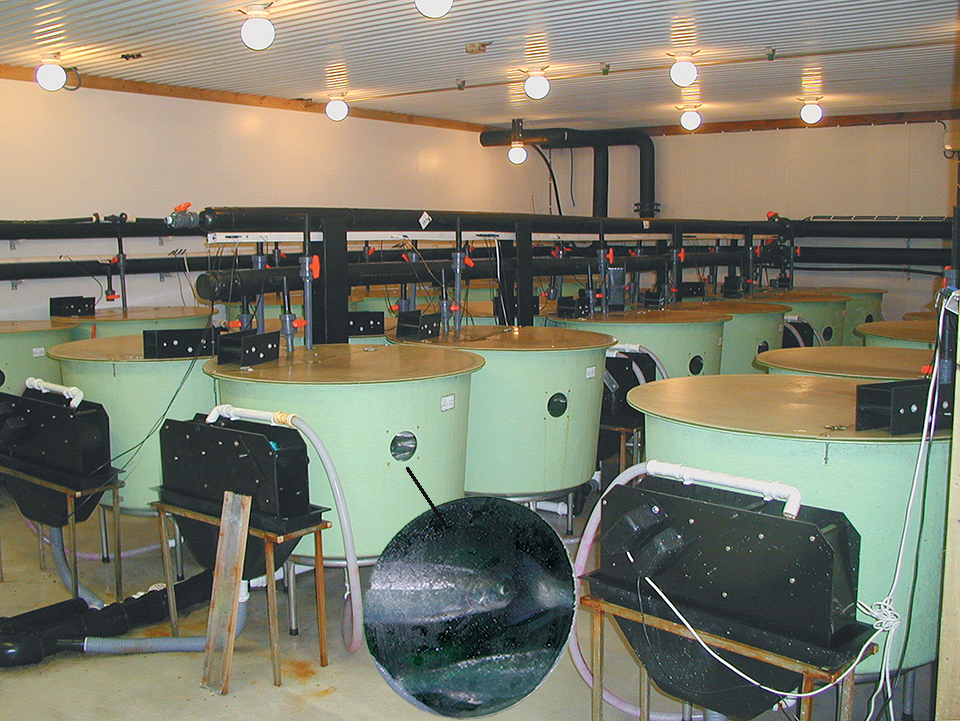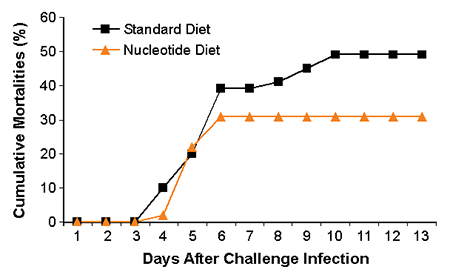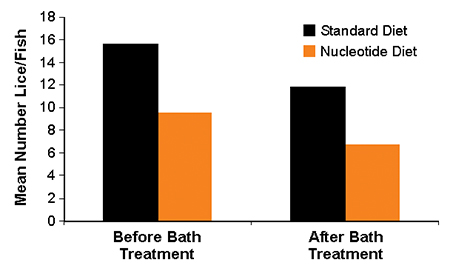Supplementation can aid disease resistance of Atlantic salmon, coho salmon and rainbow trout

Nucleotides are the basic building blocks of the nucleic acids DNA and RNA and necessary elements in the acids’ replication during cell division and renewal. As key components of cellular processes in the bodies of animals, nucleotides are considered semiessential nutrients, particularly in the very young. For example, human breast milk is particularly rich in nucleotides, and infant formulae are supplemented with them.
Nucleotides are provided endogenously by synthesis in tissues like the liver. Mammalian requirements for exogenous nucleotides vary considerably and can increase rapidly at times of fast growth or physiological stress. This increased need for nucleotides can also occur in farmed salmonid fish, where the dietary supply of nucleotides in aquafeeds should be sufficient for normal health and growth under culture conditions.
Stress and dietary demands
Aquaculture operations typically involve various physically stressful events for the cultured fish, including vaccination, handling, exposure to disease, water quality changes and other environmental variations. These stressors induce immune suppression and an increase in susceptibility to disease.
This can lead to similar increases in reliance on the dietary supply of nucleotides for optimal functions and responses, particularly in fast-growing fish. Supplementary dietary nucleotides applied in anticipation of stressful events could ensure an adequate circulating nucleotide pool for cultured fish.
EWOS trials
Trials at the EWOS Technology Centre determined the effects of the inclusion of exogenous nucleotides in aquaculture diets on the resistance of fish to challenge infections. When added to normal feed formulations at a combined inclusion level of 0.03 percent, these additional nucleotides were shown to increase resistance to bacterial, viral, and rickettsial diseases, as well as ectoparasitic infestation.
Bacterial infection

When fed a standard control diet for three weeks prior to challenge infection with the bacterium Vibrio anguillarum, rainbow trout suffered 49 percent mortalities (Fig. 1), whereas fish given the nucleotide-supplemented diet had 31 percent mortalities. Furthermore, unlike the groups fed the standard diet, those given the nucleotide diet suffered no further mortalities after day 6, suggesting a more rapid and effective immune response.
After 10 weeks of feeding, cumulative mortalities in very small fish and those due to naturally occurring Rainbow Trout Fry Syndrome caused by the bacterium Flexibacter psychrophilus were reduced by 41 percent when diets were enhanced with exogenous nucleotides.
Viral infection
Mortalities in Atlantic salmon exposed to cohabitant fish with Infectious Salmon Anaemia virus were also significantly reduced. Fish fed a standard diet for three weeks prior to exposure suffered 48 percent mortalities. This rate was reduced to 35.7 percent in those given the nucleotide-enriched diet – a significant reduction of 25.7 percent.
Rickettsial infection
In groups of Coho salmon prefed for three weeks with either standard diet or that supplemented with nucleotides prior to challenge infection with Piscirickettsia salmonis, mortalities in the nucleotide-enhanced groups were delayed by one week. The final mortality rate in the groups given the standard diet was 76.8 percent, while in the groups fed nucleotide-supplemented feed, this figure was reduced to 46.9 percent, a reduction of 38.9 percent.
Parasitic infestation

Infestation with sea lice (Lepeophtheirus salmonis) is a major problem in Atlantic salmon farming. It often involves the use of chemical treatments and baths that not only require discharge consents, but are stressful to the fish.
When fed for three weeks prior to experimental exposure to lice (Fig. 2), fish given nucleotide-enriched diets were shown to have 25 percent fewer attached lice than fish fed the standard diet. Furthermore, when fish were reintroduced to the water following bath treatment to remove the lice, those fed the nucleotide diet had 30 percent fewer lice as a result of reexposure.
Natural treatment
While vaccination is preferred over antibiotic treatments for the control of many fish diseases, vaccines for other diseases are unavailable or, at best, in the early stages of development. In addition, antibiotics are ineffective against diseases caused by viruses or infestation with parasites.
Environmentally friendly, natural feed additives such as nucleotides can increase the natural resistance of fish to infections and provide valuable adjuncts to vaccination that could lead to a reduction in the wide use of antibiotics.
Conclusion
EWOS studies have shown that the supplementation of commercial salmonid diets with additional exogenous nucleotides can exert a positive influence on the disease resistance of Atlantic salmon, coho salmon and rainbow trout to bacterial, viral, rickettsial and ectoparasitic infections. This increased resistance may be due to the availability of additional dietary nucleotides, which enhance the potential of animals’ immune systems in general to mount greater and more rapid specific responses when required.
(Editor’s Note: This article was originally published in the April 2002 print edition of the Global Aquaculture Advocate.)
Now that you've finished reading the article ...
… we hope you’ll consider supporting our mission to document the evolution of the global aquaculture industry and share our vast network of contributors’ expansive knowledge every week.
By becoming a Global Seafood Alliance member, you’re ensuring that all of the pre-competitive work we do through member benefits, resources and events can continue. Individual membership costs just $50 a year. GSA individual and corporate members receive complimentary access to a series of GOAL virtual events beginning in April. Join now.
Not a GSA member? Join us.
Author
-
Charles Burrells, FIBMS, CMLM, Ph.D.
EWOS Innovation
N-4335 Dirdal, Norway
EWOS Ltd.
Westfield, Bathgate EH48 3BP UK
Tagged With
Related Posts

Health & Welfare
Advances in tilapia nutrition, part 2
Nutrition has an important role on growth, performance and flesh quality of tilapia. Part two of this two-part series looks into mineral supplementation and feeding strategy.

Aquafeeds
Animal byproduct concentrates useful tools in formulation
With the market volatility of fishmeal, as well as rising sustainability concerns, the aquaculture industry is seeking sources of protein, such as animal byproduct concentrates, to substitute for fishmeal.

Aquafeeds
Animal co-product hydrolysates sources of key molecules in aquafeeds
Key molecules found in animal byproduct hydrolysates show potential for use as functional ingredients in aquaculture feeds. Animal co-product hydrolysates from slaughterhouse waste and rendered animal byproducts present a protein alternative.

Aquafeeds
Biosecurity protocols needed for shrimp feeds, feeding practices
Shrimp aquafeeds – live, fresh or formulated – should not be an entry point of potential pathogens to the shrimp and/or to their culture systems.


